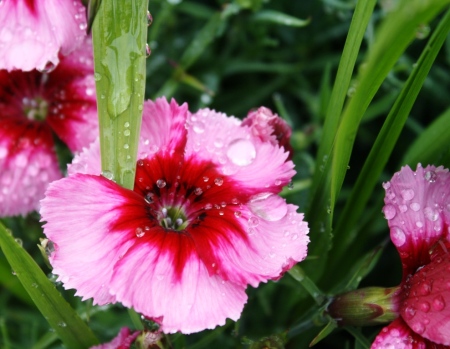My pal Kenny Stanton reads the weather station at Winterfield in Dunbar every day and sends his results off to the Met Office. He was on holiday recently and his deputy Ronnie took over. Then Ronnie was on holiday and I took over and became the Deputy Weatherman’s Deputy, something that not many people achieve in their lives, and surely ranks alongside positions such as Vice President of the USA or Steve McQueen’s stuntman in The Great Escape. It is an intriguing post to hold, particularly in relation to the use of language. The first task is to enter the weather station (photo below). For security, the station is fenced in with iron railings, so you go in as a prison warden with your keys jangling, in the style of Mr Mackay (video).
Once inside, you open the Stevenson Screen which is not a screen but a white, wooden, slatted box, which could be mistaken for a beehive, seen on the left of the photo above. It is called after the Edinburgh born engineer Sir Thomas Stevenson, the father of the author Robert Louis Stevenson i.e. the father had the novel idea first. Inside, the Stevenson Screen looks like this.
My instructions were to record the air huidity by looking at the left hand vertical thermometer and this is recorded not as air temperature but as dry bulb as the thermometer is “not affected by the moisture of the air”. The right hand vertical thermometer reading is recorded as wet bulb. “By combining the dry bulb and wet bulb temperature in a psychrometric chart or Mollier diagram the state of the humid air can be determined”. Are you still with me? So, dry and wet bulbs are not planted in the autumn and dug up in the spring, they record humidity. Wouldn’t it be good if you had something similar for humans e.g. bright bulb and dull bulb which recorded stupidity? You could do this surreptitiously and avoid people with high dull bulb reading.
There are many other readings but, at the risk of losing you, I will focus only on the sunshine element. The Met Office state that “A glass sphere focuses the sun’s direct radiation on a graduated card and the length of the burn trace on the card corresponds to the duration of sunshine”. The photo below shows the Campbell-Stokes sunshine recorder and if you’re feeling nerdy about sunshine recorders, check this out. My task was to replace the card which showed the previous day’s sunshine, with a new one.
The next photo shows the distorted view of part of the weather station through the glass orb and you get a weird sensation looking through the orb, which is 10 feet above ground.
The weather has inspired song writers and poets for many years. The Beatles (video) sang ” When the rain comes they run and hide their heads/ They might as well be dead … When the sun shines they slip into the shade/ And sip their lemonade..”. The first song heard on Radio 1 was “Flowers in the Rain” (video) by The Move. The Russian poet Anna Akhmatova wrote “Sunshine has filled the room/ with clear golden specks of dust”. In An Autumn Rain Scene, Thomas Hardy wrote “There trudges one to a merry-making/ With sturdy swing,/ On whom the rain comes down”.
We’ve had a lot of rain here recently, with heavy skies often moved along very slowly by a distinctly cool north easterly wind. One joyful aftermath of the rain is in the garden where raindrops on the flowers and leaves are a sight for sore eyes. I took these photos yesterday, to capture the ephemeral nature of the rain. An hour later, the raindrops had gone, extinguished by the sun. It’s a short existence if you’re a raindrop.






